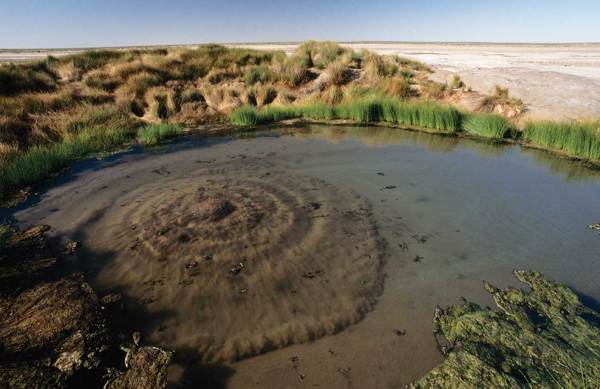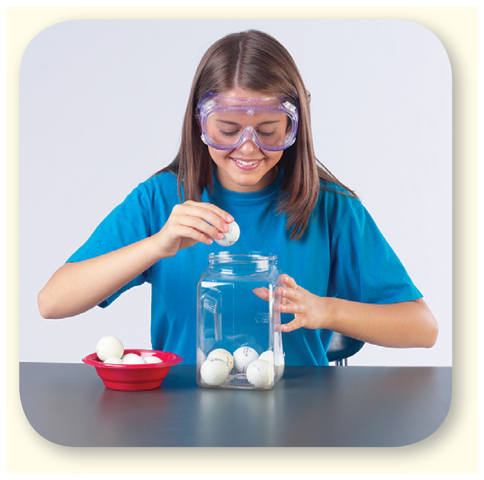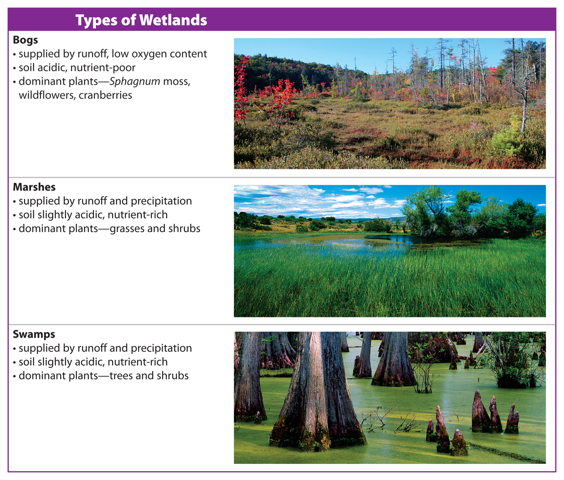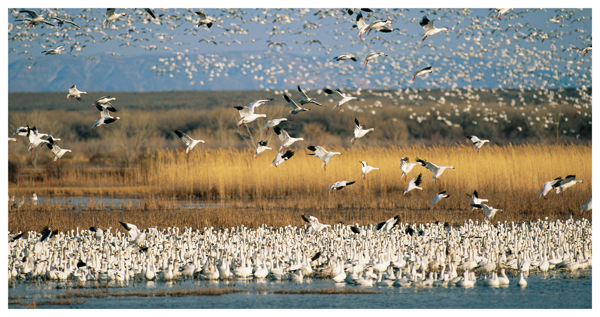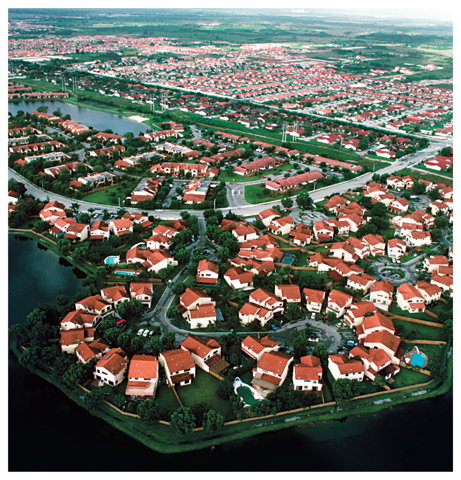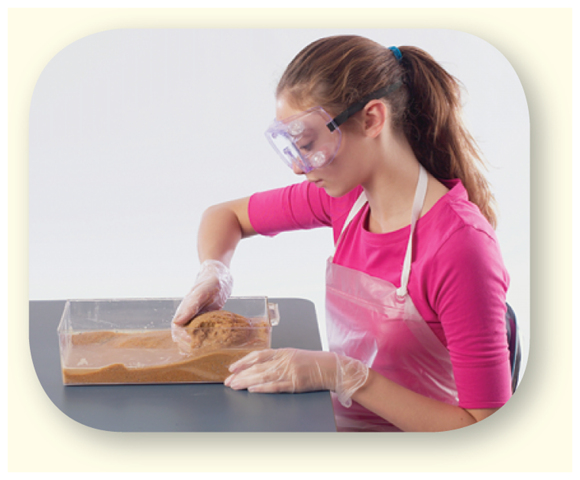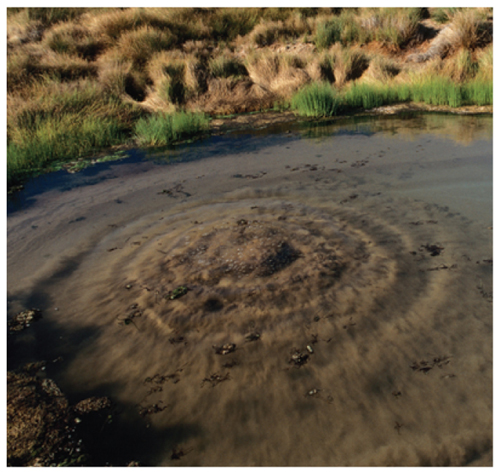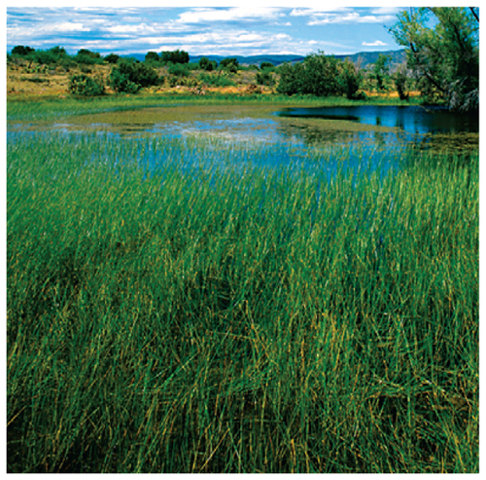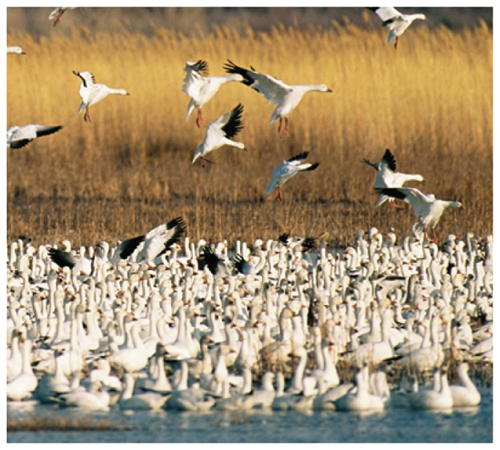 Where did this water come from?
Where did this water come from?
1
 Launch Lab: How solid is Earth’s surface?
Launch Lab: How solid is Earth’s surface? 
It feels solid, but just how solid is “solid ground”? Believe it or not, the soil and rock beneath your feet are not entirely solid.
1. Read and complete a lab safety form.
2. Fill a large, empty jar with golf balls.
3. Follow the instructions given by your teacher.
Think About This
1. At what point did you think the jar was full?
2. Do you think the particle size of the soil affects how quickly water can move through it?
3. Key Concept Does water flow more easily through sediments of equal size or sediments with a variety of different sizes?
13
Groundwater
Some water that falls to Earth as precipitation soaks into the ground. Generally, water that lies below ground is called groundwater. Water seeps through soil and into tiny pores, or spaces, between sediment and rock. If you have ever been inside a cave and seen water dripping down the sides, you’ve seen groundwater seeping through rock.
1. Key Concept Check What is groundwater?
In some areas, groundwater is very close to the surface and keeps the soil wet. In other areas, especially deserts and other dry climates, groundwater is hundreds of meters below the surface.
Groundwater can remain underground for long periods of time—thousands or millions of years. Eventually, it returns to the surface and reenters the water cycle. Humans interfere with this process, however, when they drill wells into the ground to remove water for everyday use.
Importance of Groundwater
The water beneath Earth’s surface is much more plentiful than the freshwater in lakes and streams. Recall that groundwater is about one-third of Earth’s freshwater. Groundwater is an important source of water for many streams, lakes, and wetlands. Some plant species absorb groundwater through long roots that grow deep underground.
People in many areas of the world rely on groundwater for their water supply. In the United States, about 20 percent of the water people use daily comes from groundwater.
The Water Table
As illustrated in Figure 1, groundwater seeps into tiny cracks and pores within rocks and sediment. Near Earth’s surface, the pores contain a mixture of air and water. This region is called the unsaturated zone. It is called unsaturated because the pores are not completely filled with water. Farther beneath the surface, the pores are completely filled with water. This region is called the saturated zone. The upper limit of the saturated zone is called the water table.
2.  Reading Check What is the water table?
Reading Check What is the water table?
 Reading Check What is the water table?
Reading Check What is the water table?
Porosity Rocks vary in the amount of water they can hold and the speed with which water flows through the rock. Some rocks can hold a lot of water and some rocks cannot. Porosity is a measure of rock’s ability to hold water. Porosity increases with the number of pores in the rock. The higher the porosity, the more water a rock can contain.
Permeability The measure of water’s ability to flow through rock and sediment is called permeability. This ability to flow through rock and sediment depends on pore size and the connections between the pores. Even if pore space is abundant in a rock, the pores must form connected pathways for water to flow easily through the rock.
Figure 1 Aquifers store ground water. Groundwater becomes surface water, including springs and streams, in places where the water table meets the surface of the land.
Groundwater Flow
Just as runoff flows downhill across Earth’s surface, groundwater flows downhill beneath Earth’s surface. Groundwater flows from higher elevations to lower elevations. In low-lying areas at Earth’s surface, groundwater might eventually seep out of the ground and into a stream, a lake, or a wetland, as also shown in Figure 1. In this way, groundwater can become surface water. Likewise, surface water can seep into the ground and become groundwater. This is how groundwater is replenished.
Wells People often bring groundwater to Earth’s surface by drilling wells like the one shown in Figure 1. Wells are usually drilled into an aquifer—an area of permeable sediment or rock that holds significant amounts of water. Groundwater then flows into the well from the aquifer and is pumped to the surface.
Precipitation helps replace groundwater drawn out of wells. During a drought, less groundwater is replaced, so the water level in a well drops. The same thing happens if water is removed from a well faster than it is replaced. If the water level drops too low, a well runs dry.
Springs A spring forms where the water table rises to Earth’s surface, as shown in the lesson opener. Some springs bubble to Earth’s surface only after heavy rain or snowmelt. Many springs fed by large aquifers flow continuously.
Human Impact on Groundwater
If polluted surface water seeps into the ground, it can pollute the groundwater below it. Pollutants include pesticides, fertilizers, sewage, industrial waste, and salt used to melt ice on highways. Pollutants can travel through the ground and into aquifers that supply wells. People’s health can be harmed if they drink contaminated water from a well.
The water in an aquifer helps to support the rocks and soil above it. In some parts of the world, water is being removed from aquifers faster than it can be replaced. This creates empty space underground. The empty space underground cannot support the weight of the overlying rock and soil. Sinkholes form where the ground collapses due to lack of sufficient support from below.
3. Key Concept Check How do human activities affect groundwater?
15
Wetlands
Water often collects in flat areas or depressions that are too shallow to form lakes. Conditions like these can create a wetland—an area of land that is saturated with water for part or all of the year. Wetlands also form in areas kept moist by springs, and in areas along the shores of streams, lakes, and oceans. The water in a wetland can remain still or flow very slowly.
Types of Wetlands
Scientists identify wetlands by the characteristics of the water and soil and by the kinds of plants that live there. There are three major types of wetlands, as shown in Table 1. Bogs form in cool, wet climates. They produce a thick layer of peat—the partially decayed remains of sphagnum moss. Peat holds water, so bogs rarely dry out. Unlike bogs, marshes and swamps form in warmer, drier climates and do not produce peat. Marshes and swamps are supplied by precipitation and runoff. They can temporarily dry out in hot, dry weather.
Table 1 This table shows and compares three types of wetlands.
Importance of Wetlands
Wetlands provide important habitat for plants and wildlife. They help control flooding and erosion and also help filter sediments and pollutants from water.
Habitat A wide variety of plants and animals live in wetlands, as shown in Figure 2. Wetlands provide plentiful food and shelter for young and newly hatched animals, including fish, amphibians, and birds. Wetlands are also important rest stops and food sources for migrating animals, especially birds.
Flood Control Wetlands help reduce flooding because they store large quantities of water. They fill with water during the wet season and release the water slowly during times of drought.
Erosion Control Coastal wetlands help prevent beach erosion. Wetlands can reduce the energy of wave action and storm surges—water pushed onto the shore by strong winds produced by severe storms.
Filtration Wetlands help keep sediments and pollutants from reaching streams, lakes, groundwater, or the ocean. They are natural filtration systems. Runoff that enters a wetland often contains excess nitrogen from fertilizers or animal waste. Plants and the bacteria in wetland soils absorb excess nitrogen. Wetland plants and soils also trap sediments and help remove toxic metals and other pollutants from the water.
1. Key Concept Check Why are wetlands important?
Figure 2 Wetlands are an important habitat for wildlife, providing water, food, and shelter.
Human Impact on Wetlands
Many wetlands throughout the world have been drained and filled with soil for roads, buildings, airports, and other uses. The disappearance of wetlands has also been associated with rising sea level, coastal erosion, and the introduction of species that are not naturally found in wetlands. Scientists estimate that more than half of all wetlands in the United States have been destroyed over the past 300 years.
The Louisiana coastline has lost about 310 km2 of wetlands since 1950. Figure 3 shows some of the changes that have taken place on the Louisiana coast. A lack of coastal wetlands may have contributed to widespread flooding that occurred when Hurricane Katrina struck the area in 2005.
2. Key Concept Check How do human activities affect wetlands?
Figure 3 Large portions of the coastal wetlands of Louisiana have been filled in to build roads and buildings. Scientists and engineers have proposed that future flooding could be avoided by restoring some wetland areas.
1
WORD ORIGIN
sphagnum
from Greek sphagnos, means “a spiny shrub”
from Greek sphagnos, means “a spiny shrub”
1
 MiniLab: Can you model freshwater environments?
MiniLab: Can you model freshwater environments?



Sources of groundwater and surface water are similar. When the ground becomes saturated with water following a storm, the excess water can flow into lakes or streams. Groundwater may also surface and create wetlands.
1. Read and complete a lab safety form.
2. Half fill a plastic shoebox with sand. Flatten out the surface of the sand.
3. While watching the side of the box as you pour, add enough water so the water level, or water table, is even with the top of the sand.
4. Scoop some sand from one end of the box and pile the excess sand on the other end of the box to form highlands. Create an area between the scooped hole and the pile where the level of the sand is at the water table.
5. View the plastic shoebox from the side. Draw a cross section of your model in your Science Journal. Include the water table on your cross section.
6. Add a few drops of food coloring to the highlands to represent pollution. Using a paper cup with holes in the bottom, model precipitation by dripping water down over your model. Observe.
Analyze and Conclude
1. Label the lake, wetlands, highlands and water table on your diagram and identify where the water table is above, at the same level as, and below the surface.
2. Describe the path the “pollution” follows.
3. Key Concept How does this lab demonstrate the behavior of groundwater?
Lesson Review
Visual Summary
Groundwater fills pores in soil and rocks in the saturated zone. The water table marks the top of the saturated zone.
A wetland is an area of land that is saturated with water for part or all of the year.
Human involvement in alteration and destruction of wetlands can have devastating effects.
What do you think NOW?
You first read the statements below at the beginning of the lesson.
5. People use groundwater as a source of water.
6. Wetlands can naturally filter pollutants from groundwater.
Did you change your mind about whether you agree or disagree with the statements? Rewrite any false statements to make them true.
Lesson Assessment
Use Vocabulary
1. Distinguish between porosity and permeability.
2. Use the term groundwater in a complete sentence.
3. Define water table in your own words.
Understand Key Concepts
4. Where is the saturated zone located?
A. above the water table
B. below the water table
C. beside the water table
D. within the water table
5. Explain how groundwater can become surface water.
6. Explain how groundwater that is used as drinking water reaches homes.
7. List three reasons wetlands are important to people and the environment.
8. Which is NOT a reason wetlands are important?
A. affect climate
B. control erosion
C. filter out pollutants
D. provide wildlife habitat
9. Which type of wetland is shown in the photo below?
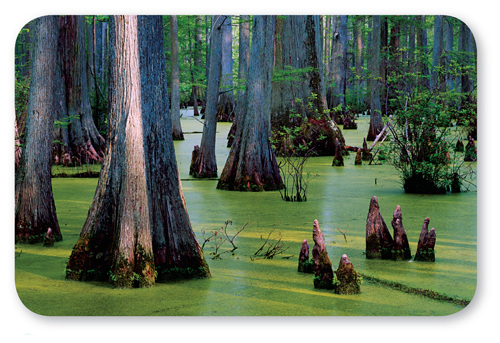

Panoramic Images/Getty Images
A. bog
B. fen
C. marsh
D. swamp
10. How does a well run dry?
A. Groundwater is removed more slowly than it is replaced.
B. Groundwater is removed more quickly than it is replaced.
C. Groundwater gets trapped in an aquifer.
D. Groundwater becomes contaminated with pollutants.
Interpret Graphics
11. Organize Information Copy and fill in the graphic organizer below to describe the different types of wetlands.
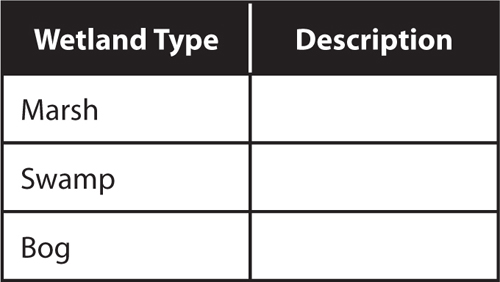

Critical Thinking
12. Design an experiment to test whether groundwater from a well has been contaminated by wastewater from a nearby sewage treatment plant.
13. Explain A local developer wants to drain a wetland in your city and build a shopping mall in its place. Write a letter to the editor of your local newspaper to explain the possible outcome of the development.
14. Infer why wetlands are good habitats for newly hatched and juvenile animals, such as fish and amphibians.
15. Explain how humans affect wetlands.
16. Compare and contrast an aquifer and a spring.
17. Design a model that would help you explain the difference between porosity and permeability to a group of elementary school students.
18. Where is Earth’s freshwater? Describe its general form, such as ice or liquid water. Also describe its general location, such as above ground, below ground, etc. Approximately what percentage of Earth’s freshwater is at these locations?
19. What type of wetland appears in the photo below?
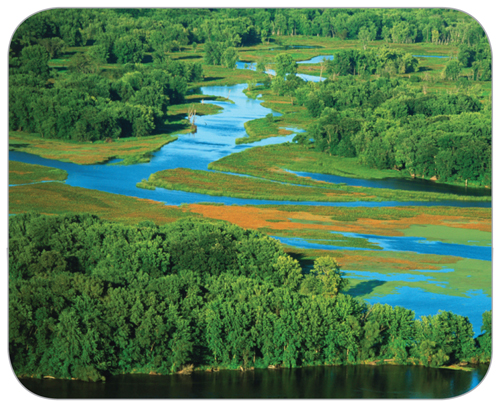

Jon Spaull/Getty Images



